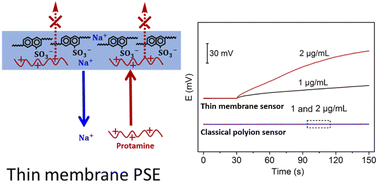Thin membrane-based potentiometric sensors for sensitive detection of polyions†
Abstract
A novel protocol for development of sensitive and rapid polymeric membrane polyion sensitive electrodes has been explored in this work. In contrast to the traditional polyion electrodes which usually have a sensing membrane thickness of 100∼200 μm, a thin membrane electrode with a membrane thickness of 5 μm is proposed to detect polyions. By using such thin membrane configuration, the diffusion of polyions from the organic boundary layer into the bulk of the membrane can be effectively blocked. The induced accumulation of polyions in the membrane boundary layer largely enhances the obtained potential response. It has been found that the proposed electrode shows a remarkably improved sensitivity and measurement time over conventional potentiometric polyion sensors based on the thick membranes. By using protamine as a model of polyions, the new concept offers a detection limit nearly two orders of magnitude lower than those obtained by the traditional thick-membrane polyion electrodes for potentiometric measurements of polyions. The proposed polyion sensing platform offers great promise in the sensitive and rapid detection of polyions as well as other polyion-involved bioanalyses.



 Please wait while we load your content...
Please wait while we load your content...